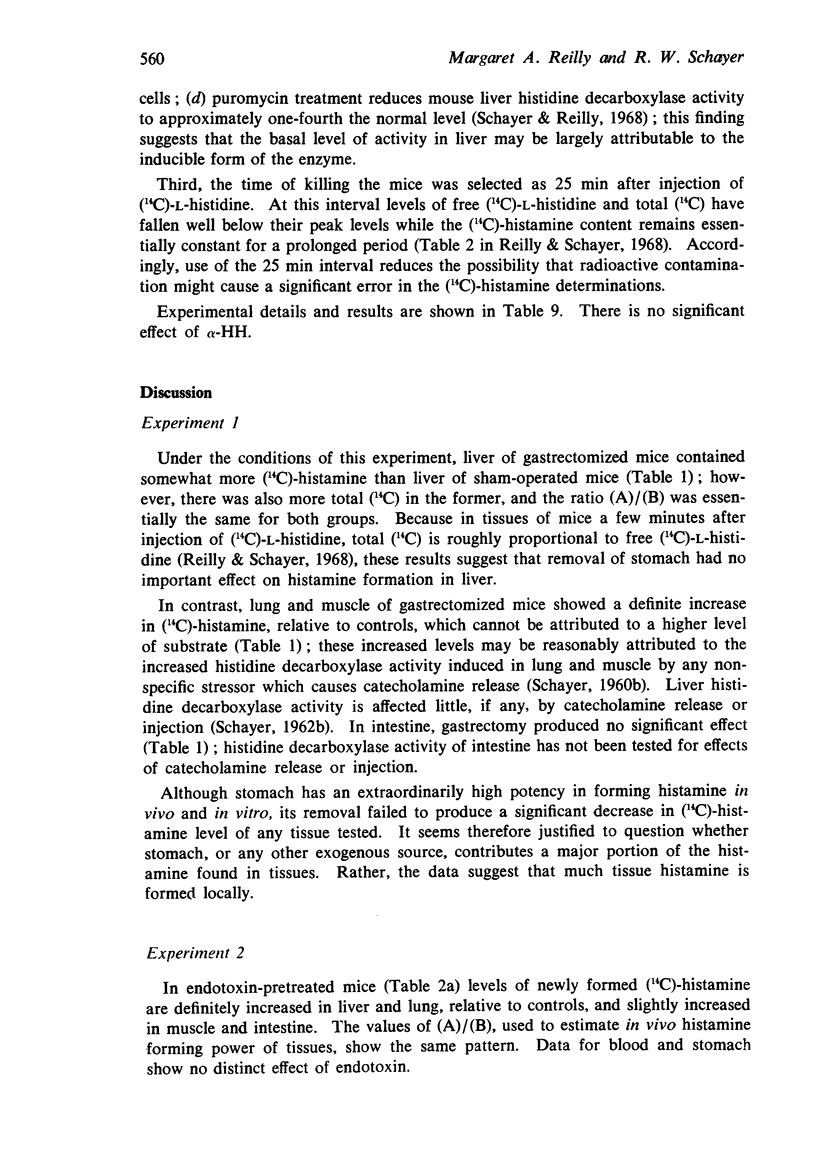Abstract
1. Mice were injected with (14C)-L-histidine, killed at various intervals, and tissues assayed for (14C)-histamine. In some cases free (14C)-L-histidine and total (14C) were also determined.
2. Removal of stomach, the most active histamine-forming tissue, failed to reduce the (14C)-histamine content of any tested tissue; (14C)-histamine concentrations in lung and muscle of gastrectomized mice were higher than in shamoperated controls.
3. In mice pretreated with endotoxin and subsequently injected with (14C)-L-histidine, the (14C)-histamine content of liver, lung and muscle was markedly higher than in controls. The increased concentrations of (14C)-histamine in endotoxin-pretreated mice seemed to reflect a greater rate of formation; they could be attributed neither to changes in tissue concentration of (14C)-L-histidine, to increased uptake from other tissues, nor to impaired ability to inactivate histamine.
4. Results of studies on in vivo effectiveness of several histidine decarboxylase inhibitors are reported.
5. The following conclusions are supported by the evidence presented: (a) in stressed mice, those tissues which show activation of histidine decarboxylase also show increased ability to form histamine in vivo; (b) tissue histamine is largely formed locally; (c) histidine decarboxylase inhibitors are highly effective in blocking histamine formation in mast cells and in stomach, but do not normally reach the locus of an inducible form of histidine decarboxylase; (d) the inducible form of histidine decarboxylase in liver may be located in phagocytic microvascular endothelial cells; (e) in conditions favouring near-maximal activation of histidine decarboxylase, the histamine-methylating enzyme of liver and diamine oxidase of intestine showed no inducible characteristics; (f) blood histamine concentrations do not accurately reflect changes in tissue histamine formation.
Full text
PDF












Selected References
These references are in PubMed. This may not be the complete list of references from this article.
- Håkanson R., Owman C. Concomitant histochemical demonstration of histamine and catecholamines in enterochromaffin-like cells of gastric mucosa. Life Sci. 1967 Apr 1;6(7):759–766. doi: 10.1016/0024-3205(67)90133-6. [DOI] [PubMed] [Google Scholar]
- Johnston M., Kahlson G. Experiments on the inhibition of histamine formation in the rat. Br J Pharmacol Chemother. 1967 Jun;30(2):274–282. doi: 10.1111/j.1476-5381.1967.tb02134.x. [DOI] [PMC free article] [PubMed] [Google Scholar]
- Kahlson G., Rosengren E. New approaches to the physiology of histamine. Physiol Rev. 1968 Jan;48(1):155–196. doi: 10.1152/physrev.1968.48.1.155. [DOI] [PubMed] [Google Scholar]
- LEVINE R. J., SATO T. L., SJOERDSMA A. INHIBITION OF HISTAMINE SYNTHESIS IN THE RAT BY ALPHA-HYDRAZINO ANALOG OF HISTIDINE AND 4-BROMO-3-HYDROXY BENZYLOXYAMINE. Biochem Pharmacol. 1965 Feb;14:139–149. doi: 10.1016/0006-2952(65)90069-9. [DOI] [PubMed] [Google Scholar]
- Reilly M. A., Schayer R. W. Studies on the histidine-histamine relationship in vivo. Br J Pharmacol Chemother. 1968 Mar;32(3):567–574. doi: 10.1111/j.1476-5381.1968.tb00456.x. [DOI] [PMC free article] [PubMed] [Google Scholar]
- SCHAYER R. W. A UNIFIED THEORY OF GLUCOCORTICOID ACTION. Perspect Biol Med. 1964;7:71–84. doi: 10.1353/pbm.1964.0006. [DOI] [PubMed] [Google Scholar]
- SCHAYER R. W. Catabolism of physiological quantities of histamine in vivo. Physiol Rev. 1959 Jan;39(1):116–126. doi: 10.1152/physrev.1959.39.1.116. [DOI] [PubMed] [Google Scholar]
- SCHAYER R. W. Evidence that induced histamine is an intrinsic regulator of the microcirculatory system. Am J Physiol. 1962 Jan;202:66–72. doi: 10.1152/ajplegacy.1962.202.1.66. [DOI] [PubMed] [Google Scholar]
- SCHAYER R. W. Histidine decarboxylase in mast cells. Ann N Y Acad Sci. 1963 Feb 26;103:164–178. doi: 10.1111/j.1749-6632.1963.tb53696.x. [DOI] [PubMed] [Google Scholar]
- SCHAYER R. W. Induced synthesis of histamine, microcirculatory regulation and the mechanism of action of the adrenal glucocorticoid hormones. Prog Allergy. 1963;7:187–212. [PubMed] [Google Scholar]
- SCHAYER R. W. Relationship of induced histidine decarboxylase activity and histamine synthesis to shock from stress and from endotoxin. Am J Physiol. 1960 Jun;198:1187–1192. doi: 10.1152/ajplegacy.1960.198.6.1187. [DOI] [PubMed] [Google Scholar]
- SCHAYER R. W. Relationship of stress-induced histidine decarboxylase to circulatory homeostasis and shock. Science. 1960 Jan 22;131(3395):226–227. doi: 10.1126/science.131.3395.226. [DOI] [PubMed] [Google Scholar]
- SCHAYER R. W. Role of induced histamine intourniquet shock in mice. Am J Physiol. 1962 Sep;203:412–416. doi: 10.1152/ajplegacy.1962.203.3.412. [DOI] [PubMed] [Google Scholar]
- SCHAYER R. W. Studies on histaminemetabolizing enzymes in intact animals. J Biol Chem. 1953 Aug;203(2):787–793. [PubMed] [Google Scholar]
- Schayer R. W. A unified theory of glucocorticoid action. II. On a circulatory basis for the metabolic effects of glucocorticoids. Perspect Biol Med. 1967 Spring;10(3):409–418. doi: 10.1353/pbm.1967.0037. [DOI] [PubMed] [Google Scholar]
- Schayer R. W. Determination of histidine decarboxylase activity. Methods Biochem Anal. 1968;16:273–291. doi: 10.1002/9780470110348.ch5. [DOI] [PubMed] [Google Scholar]
- Schayer R. W. Histamine and circulatory homeostasis. Fed Proc. 1965 Nov-Dec;24(6):1295–1297. [PubMed] [Google Scholar]
- Schayer R. W., Reilly M. A. Suppression of inflammation and histidine decarboxylase by protein synthesis inhibitors. Am J Physiol. 1968 Aug;215(2):472–476. doi: 10.1152/ajplegacy.1968.215.2.472. [DOI] [PubMed] [Google Scholar]


